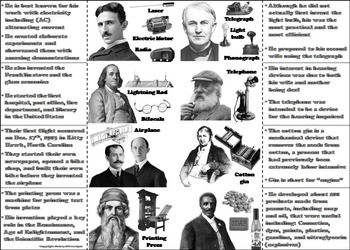Inventing is a term which simply talks about the process of creating something that was never existing before, thereby solving a need or a problem, Mankind is forever thankful and would never forget the likes of inventors as- Mark Dean, Madam Walker, Richard Drew, Shirley Jackson, Marie Van, Patricia Bath a host of others. Can you imagine life without blood banks, personal computers, or touch-tone telephones? These innovative creations and more would not exist today if it weren’t for the brilliant minds of many great inventors. Below is a list of some very notable inventors.
1. Thomas L. Jennings

(1791-1859) Thomas L. Jennings was the first African American person to receive a patent in the U.S made the way for future inventors of color to gain exclusive rights to their inventions. Thomas Jennings was Born in 1791, Jennings lived and worked in New York City as a tailor and dry cleaner. He invented an early method of dry cleaning called “dry scouring” and patented it in 1821—four years before Paris tailor Jean Baptiste Jolly refined his own chemical technique and established what many people claim was history’s first dry cleaning business.
During the period he was to be granted the permission to receive a patent as an African American people objected to it, but Jennings had an escape route: He was a free man. At that time, U.S patent laws state that the “[slavemaster] is the owner of the fruits of the labor of the slave both manual and intellectual”—meaning slaves couldn’t legally own their ideas or inventions, but nothing was stopping Jennings. Several decades later, The Congress extended patent rights to all African American individuals, both slaves, and freedmen. After he was awarded, Jennings used the money from his invention to free the rest of his family and donate to abolitionist causes.
2. Mark E. Dean

In ancient times if anyone has actually owned the original IBM personal computer, you can partially credit its existence to Mark E. Dean (born 1957). This computer scientist/engineer worked for IBM, where he led the team that designed the ISA bus —the hardware interface that allows multiple devices like printers, modems, and keyboards to be plugged into a computer. This innovation helped pave the way for the personal computer’s use in office and business settings.
Dean also developed the first color computer monitor, and in 1999 he led the team of programmers that created the ” World’s first gigahertz chip “. Today, the computer scientist holds three of the company’s original nine patents, and more than 20 overall. Dean was inducted into the National Inventors Hall of Fame in 1997. He is also a computer science professor at the University of Tennessee.
3. Madam C.J. Walker

Madam C.J. Walker as popularly known is often referred to as America’s first self-made female millionaire—Which is such so amazing regarding her roots as the daughter of Louisiana sharecroppers. The entrepreneur’ Breedlove’ was born in 1867, and her early life was filled with hardships: At the age of 20, she was both an orphan and a widow. Breedlove’s fortunes changed after she moved to St. Louis, where her brothers worked as barbers. She suffered from hair loss and was used to experiment with various products, including hair care recipes developed by African American businesswoman named Annie Malone.
Breedlove became a sales representative for Malone and relocated to Denver, where she also married her husband, Charles Joseph Walker, a St. Louis newspaperman. Soon after, she began selling her own hair-growing formula developed specifically for African American women. Breedlove renamed herself “Madam C.J. Walker,” which heavily promoted her products, and she established several beauty schools, salons, and training facilities across America. She died a famous millionaire and is today considered to be one of the founders of the African American hair-care and cosmetics industry.
4. Dr. Shirley Jackson

The theoretical physicist “ Dr. Shirley Jackson” who served as president of Rensselaer Polytechnic Institute in Troy, New York. While working at the former AT&T Bell Laboratories, helped developed technologies that led to the invention of the portable fax, the touch-tone telephone, solar cells, fiber optic cables, and the technology enabling caller ID and call waiting. Jackson was also the first black woman to graduate with a Ph.D. from M.I.T., and the first to be named chair of the U.S. Nuclear Regulatory Commission.
5. Charles Richard Drew

Charles Richard Drew (1904-1950), was a physician responsible for America’s first major blood banks to which a countless number of individuals owe their lives to. Richard Drew attended McGill University College of Medicine in Montreal, where he specialized in surgery. During a post-graduate internship and residency, the young doctor studied transfusion medicine—and later, while studying at Columbia University on fellowship, he refined key methods of collecting, processing, and storing plasma.
In 1940, when World War II was in full swing, Drew was put in charge of a project called “Blood for Britain.” He helped collect thousands of pints of plasma from New York hospitals and shipped them overseas to treat European soldiers. Drew is also responsible for introducing the use of ” Bloodmobiles”—refrigerated trucks that transport blood. The following year, Drew developed another blood bank for military personnel, under the American Red Cross—an effort that grew into the American Red Cross Blood Donor Service. Eventually, he resigned in protest after he discovered that the military separated blood donations according to race. Drew spent the remainder of his life working as a surgeon and a professor, and in 1943, he became the first African American doctor to be chosen as a member of the American Board of Surgery.
6. Marie Van Brittan Brown

Marie Van Brittan Brown (1922-1999), a nurse and inventor who invented a precursor to the modern home TV security system. The crime rate which was high as at that time in Brown’s New York City neighborhood and the local police didn’t always respond to emergencies. To feel safer, Brown and her husband developed a way for a motorized camera to peer through a set of peepholes and project images onto a TV monitor. The device also included a two-way microphone to speak with a person outside, and an emergency alarm button to notify the police. The Browns filed a patent for their closed-circuit television security system in 1966, and it was approved on December 2, 1969.
7. George Carruthers
George Carruthers who was (born in 1939) is an astrophysicist who spent much of his career working with the Space Science Division of the Naval Research Laboratory (NRL) in Washington, D.C. He is most famous for creating the ultraviolet camera/spectrograph, which NASA used when it launched Apollo 16 in 1972. It helped prove that molecular hydrogen existed in interstellar space, and in 1974 space scientists used a new model version of the camera to observe Halley’s Comet and other celestial phenomena on the U.S.’s first space station, Skylab. Carruthers was inducted into the National Inventors Hall of Fame in 2003.
8. Dr. Patricia Bath

The ophthalmologist Dr. Patricia Bath who was (born in 1942) revolutionized the field of ophthalmology when she invented a device that refined laser cataract surgery, called the Laserphaco Probe. She patented the invention in 1988, and today she is being recognized as the first African American woman doctor to receive a medical patent. Bath is a trailblazer and also a genius in other areas, She was the first African American to finish a residency in ophthalmology; the first woman to chair an ophthalmology residency program in the U.S and she co-founded the American Institute for the Prevention of Blindness. Bath’s research on health disparities between African American patients and other patients gave birth to a new discipline, “community ophthalmology,” in which volunteer eye workers offer primary care and treatment to underserved populations.
9. Jan Ernst Matzeliger

Far back in ancient times, history records that there was a time no one knew or could afford to get a shoe. This incident changed after Jan Ernst Matzeliger came up with his invention. Matzeliger who was an immigrant from Dutch Guiana (today called Surinam), worked as an apprentice in a Massachusetts shoe factory. Matzeliger invented the automated shoemaking machine that attached a shoe’s upper part to its sole. Once it was refined, the device could make 700 pairs of shoes each day— which was far better from the 50 per day that the average worker once sewed by hand. Matzeliger’s creation led to lower shoe prices, making them finally within financial reach for the average person.
10. Alexander Miles

Alexander Miles’s ( born in the 1830s–1918) not much about his life was known back then, but he was an inventor who lived in Duluth, Minnesota, where he designed an important safety feature for elevators and their automatic doors. During the 19th century, passengers had to manually open—and close—doors to both the elevator and its shaft. If a rider forgot to close the shaft door, other people risked accidentally falling down the long, vertical hole. Miles’s design was patented in 1867, which allowed both of these doors to close at once, preventing unfortunate accidents in the making. Today’s elevators still employ a similar technology.
11. George Washington Carver








